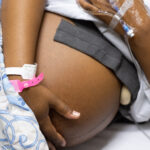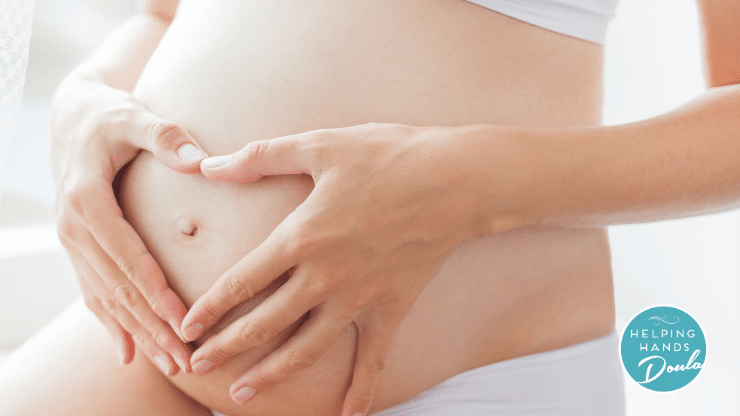What are the Different Types of Contractions and What They Mean?
𝐏𝐫𝐚𝐜𝐭𝐢𝐜𝐞 𝐂𝐨𝐧𝐭𝐫𝐚𝐜𝐭𝐢𝐨𝐧𝐬 “𝐁𝐫𝐚𝐱𝐭𝐨𝐧 𝐇𝐢𝐜𝐤𝐬”
| 𝗪𝐡𝐚𝐭 𝐢𝐬 𝐡𝐚𝐩𝐩𝐞𝐧𝐢𝐧𝐠?
-Uterine muscles contract and release -Usually in response to uterus stretching or baby moving -Like a muscle twitch |
𝗪𝐡𝐚𝐭 𝐝𝐨𝐞𝐬 𝐢𝐭 𝐟𝐞𝐞𝐥 𝐥𝐢𝐤𝐞?
-Strong tightening -Someone giving you a uncomfortable hug -Usually felt in front of belly |
| 𝗪𝐡𝐞𝐧 𝐢𝐧 𝐩𝐫𝐞𝐠𝐧𝐚𝐧𝐜𝐲 𝐝𝐨𝐞𝐬 𝐢𝐭 𝐮𝐬𝐮𝐚𝐥𝐥𝐲 𝐬𝐭𝐚𝐫𝐭?
-Could start as early as 6 weeks pregnant |
𝗪𝐡𝐚𝐭 𝐢𝐬 𝐭𝐡𝐞 𝐞𝐟𝐟𝐞𝐜𝐭 𝐨𝐧 𝐚𝐜𝐭𝐢𝐯𝐢𝐭𝐲?
-May change or stop with activity or position changes |
| 𝐇𝐨𝐰 𝐭𝐨 𝐚𝐬𝐬𝐞𝐬?
-Don’t have a regular pattern -Usually weak in intensity -Do not get stronger over time |
𝗪𝐡𝐚𝐭 𝐬𝐡𝐨𝐮𝐥𝐝 𝐲𝐨𝐮 𝐝𝐨?
-Continue with daily activity as normal -𝘔𝘦𝘴𝘴𝘢𝘨𝘦 𝘺𝘰𝘶𝘳 𝘥𝘰𝘶𝘭𝘢 𝘵𝘰 𝘤𝘰𝘯𝘧𝘪𝘳𝘮 |
Early Labour Contractions

| 𝗪𝐡𝐚𝐭 𝐢𝐬 𝐡𝐚𝐩𝐩𝐞𝐧𝐢𝐧𝐠?
-Uterine muscles contract and release -Cervix changes in thickness, position, softens and opens a small amount -Baby moves slightly lower and puts more pressure on cervix -0-6 cms |
𝗪𝐡𝐚𝐭 𝐝𝐨𝐞𝐬 𝐢𝐭 𝐟𝐞𝐞𝐥 𝐥𝐢𝐤𝐞?
-Menstrual cramps -Typically low in pelvis |
| 𝗪𝐡𝐞𝐧 𝐢𝐧 𝐩𝐫𝐞𝐠𝐧𝐚𝐧𝐜𝐲 𝐝𝐨𝐞𝐬 𝐢𝐭 𝐮𝐬𝐮𝐚𝐥𝐥𝐲 𝐬𝐭𝐚𝐫𝐭?
-With first baby it typically starts after 35 weeks and usually closer to 39-40 weeks -Subsequent pregnancies can start as early at 20 weeks |
𝗪𝐡𝐚𝐭 𝐢𝐬 𝐭𝐡𝐞 𝐞𝐟𝐟𝐞𝐜𝐭 𝐨𝐧 𝐚𝐜𝐭𝐢𝐯𝐢𝐭𝐲?
-Usually increases with activity -Decreases with rest |
| 𝐇𝐨𝐰 𝐭𝐨 𝐚𝐬𝐬𝐞𝐬?
-5-60 mins apart or more -Last for 15-45 secs -Usually described as mild in intensity -Can answer questions during a contraction |
𝗪𝐡𝐚𝐭 𝐬𝐡𝐨𝐮𝐥𝐝 𝐲𝐨𝐮 𝐝𝐨?
-Take a bath -Get some sleep -Stay hydrated and eat light meals -Be patient -Message your doula with updates or changes in pattern |
𝐀𝐜𝐭𝐢𝐯𝐞 𝐋𝐚𝐛𝐨𝐮𝐫 𝐂𝐨𝐧𝐭𝐫𝐚𝐜𝐭𝐢𝐨𝐧𝐬

| 𝗪𝐡𝐚𝐭 𝐢𝐬 𝐡𝐚𝐩𝐩𝐞𝐧𝐢𝐧𝐠?
-Uterine contractions are continuing to thin the cervix and dilate to approx. 7 cms |
𝗪𝐡𝐚𝐭 𝐝𝐨𝐞𝐬 𝐢𝐭 𝐟𝐞𝐞𝐥 𝐥𝐢𝐤𝐞?
-Strong menstrual cramps -Radiation to or from low back |
| 𝗪𝐡𝐞𝐧 𝐢𝐧 𝐩𝐫𝐞𝐠𝐧𝐚𝐧𝐜𝐲 𝐝𝐨𝐞𝐬 𝐢𝐭 𝐮𝐬𝐮𝐚𝐥𝐥𝐲 𝐬𝐭𝐚𝐫𝐭?
-Typically after 37 weeks and closer to 40-41 weeks for first time pregnancies |
𝗪𝐡𝐚𝐭 𝐢𝐬 𝐭𝐡𝐞 𝐞𝐟𝐟𝐞𝐜𝐭 𝐨𝐧 𝐚𝐜𝐭𝐢𝐯𝐢𝐭𝐲?
-Is not affected by activty or rest -Continues to get more intense over time |
| 𝐇𝐨𝐰 𝐭𝐨 𝐚𝐬𝐬𝐞𝐬?
-3-5 mins apart -60+ secs long -Contractions do not go away with a bath or rest -Do not like talking during a contraction -Prefer to focus and breathe |
𝗪𝐡𝐚𝐭 𝐬𝐡𝐨𝐮𝐥𝐝 𝐲𝐨𝐮 𝐝𝐨?
-Find a rhythm to breath and body movements -Rocking/swaying -Stay upright as much as possible -Drink fluids -Eat small bites of easily digested foods right after a contraction finishes -Use heat on low back -Take shower or bath as desired -Massage low back and hips |
We are now into the final stage of contractions and in the homestretch now!
Baby will be here before you know it, you are strong and you can do it!
Transition Contractions

| What is happening
-Dilating cervix from 7-10 cms -Shifting to moving baby down and into pushing position |
What does it feel like?
-Feelings of overwhelm -Rush of emotions -Strong contractions that may be accompanied by a feeling of “”pressure””” |
| When in pregnancy does it usually start?
-End of active labour |
What is the effect on activity? -Is not effeced by activity |
| How to asses?
-2 mins apart -90 secs long -Very intense -Trouble coping with contractions |
What should you do?
-Stay positive, your baby is coming -Focus on not pushing until the cervix is fully dilated -Use ‘H’ sound like “”ha, ho, who, house etc” -Use polar bear postion to ease urge to push |
Hopefully this information provides a little more clarity and helps prepare you for the journey that is to come. Do you have any further questions? We would love to chat! Contact us now for a complementary consultation.









No Comments